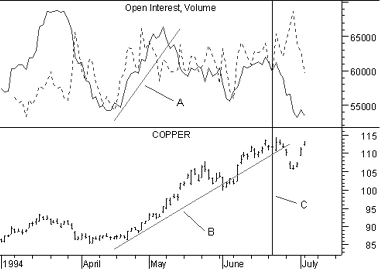|
OPEN INTEREST
Overview
Open Interest is the number of open contracts of a given future or option contract.
An open contract can be a long or short contract that has not been exercised, closed out,
or allowed to expire. Open interest is really more of a
data field than an indicator.
A fact that is sometimes overlooked is that a futures contract always involves a buyer
and a seller. This means that one unit of open interest always represents two people, a
buyer and a seller.
Open interest increases when a buyer and seller create a new contract. This happens
when the buyer initiates a long position and the seller initiates a short position. Open
interest decreases when the buyer and seller liquidate existing contracts. This happens
when the buyer is selling an existing long position and the seller is covering an existing
short position.
Interpretation
By itself, open interest only shows the liquidity of a specific contract or market.
However, combining volume analysis with open interest sometimes provides subtle clues to
the flow of money in and out of the market:
Example
The following chart shows Copper, open interest (the solid line), and volume (the dotted
line).
 The open interest is for all copper contracts, not just the current contract. The open interest is for all copper contracts, not just the current contract.
I drew a trendline ("A") when both open interest and volume were increasing. This
confirmed the upward trend of prices as shown by the trendline ("B").
I then drew a vertical line ("C") when open interest and volume began to diverge. From
this point, volume continued to increase while open interest decreased sharply. This
warned of an end to the rising trend.
|

